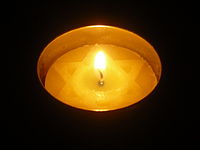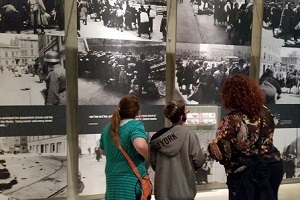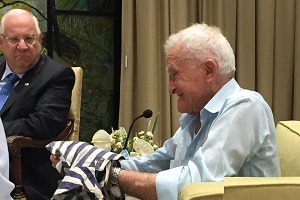Beyond the Barbed Wire Encampment, A Story Of Unity
By Nurit Greenger
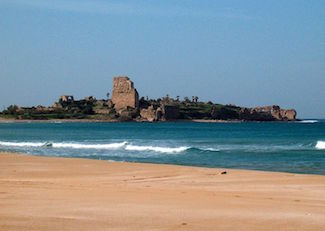
Atlit, the ruined fortress
Atlit is a small Israeli town on the Mediterranean Sea, twelve miles south of Haifa. Due to its natural large bay – second only to Haifa – the site was inhabited as early as the Canaanite and Israelite period. Later it was a Phoenician port and functioned as a port during the Persian, Hellenistic, Roman and Byzantine periods.
The Crusaders built a large castle at Atlit to protect the pilgrims’ road along the coast from Acre to Jerusalem and Atlit was the last remaining Crusader outpost in the Holy Land. After the Crusaders retreated in 1291 A.D., it was partially destroyed, later to be repaired and held by the Mamlukes. During Napoleon’s failed expedition to conquer Acre in 1799, Atlit served as a French navy port. In the 19th century, the fort was heavily damaged by an earthquake, and many of its stones were looted and reused by the Turks in other cities, when they occupied the land.
The modern town of Atlit was founded in 1903, under the auspices of Baron Edmond de Rothschild who was purchasing land for the Jews in the Holy Land.
As the 1930s drew to a close, the British, seeking to enforce the provisions of the various White Papers decree, which severely limited Jewish immigration, built a detainment camp in Atlit. Its purpose was to house stateless Jewish refugees who were called Ma’apilim, from Europe who attempted to violate the blockade and enter British Palestine.
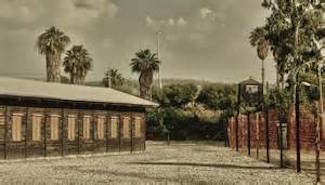
Atlit British detention camp for Jews in Palestine
After WWII ended, the Atlit camp that was surrounded by barbed wire and watchtowers, a reminder of the Nazi concentration camps, “housed” Holocaust survivors. Among them was my 23-year-old mother, a Holocaust survivor, Rachel.
When they entered the camp, the detainees were sprayed with DDT, then told to undress and enter the showers, all reminiscent of their Nazi camp detention. Men were sent to one side, women to the other. Some of those interned remained as long as 23 months. From 1939 until 1948, the jailed immigrants were housed in eighty rectangular wooden huts, each containing 40 bunks.
Atlit detention camp had horrific similarities to Nazi concentration camps. For Holocaust survivors the showers, the disinfection process, the long barracks lined with cots, and the barbed wire were appalling reminders of what they had so recently experienced and survived. Still, for the Ma’apilim (illegal immigrants) even a detention camp in the land of Israel was a symbol of new chance to a new life and future in a Jewish state.
Nowadays, the State of Israel is facing many challenges and one effective tool to overcome a challenge is unity. What transpired in Atlit on October 9, 1945, when Jewish leaders in Palestine came to the rescue the detainees is what one calls unity and strength of a nation.

The Jews vs. their British guards in Atlit
As the story is told, among the detainees were 40 Iraqi Jewish ma’apilim-refugees who managed to sneak into British Palestine in 1945, were captured and brought to Atlit. The British however had something else in store for them; they decided to send these Iraqi Jewish ma’apilim back to Iraq. No way, said the Jewish leaders in Palestine and immediately decided to organize an operation to rescue them as well as empty out the rest of the camp, where over 200 babies, children, men and women were being held captive for the “crime” of entering their Jewish homeland without the British permission. The commander of the operation was Nahum Sarig; second in command was Israel’s former Prime Minister, the late Yitzhak Rabin.
Tuesday, October 9, 1945 was the slated date for the rescuing operation. That night, all seemed quiet at the camp into where six Palmach, pre-state commandos, members unit had infiltrated the camp earlier in the guise of Hebrew teachers. Silently and stealthily they cut the camp barbed-wire fences and after they took out the guards, a larger Palmach force entered the camp.
Carrying babies and toddlers on their backs, the Palmachniks led the detainees into the darkness of the night. They walked through the fields behind Atlit and then started to climb the rocky and thorny Mount Carmel. Their calculation was that the rescued will make it to Kibbutz Beit Oren, nestled at the top of the mountain, before dawn, and manage to hide before the British authorities could find them. But the rescued detainees were not as physically fit as their rescuers. As the darkness of the night was coming to an end it became clear that they will not make it to the top of the mountain and the British will not only recapture them but the Palmachniks stood to face harsh punishment.
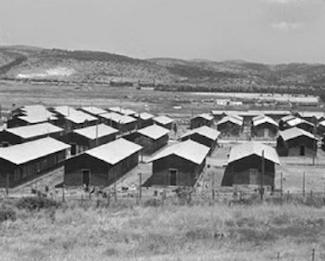
Atlit view of the detainee-camp
What transpired next was the epitome of brothers united.
Thirty of the rescued detainees got lost and tramped all the way to Haifa; the rest made it to Kibbutz Beit Oren on top of the mountain and Kibbutz Yagur, to the east of Haifa, where they mingled with thousands of Jews from the area who had come together and gathered there to confuse the British so they would not know who is a local and who is an escapee. It worked; not one of the escapees was recaptured.
At its peak, Atlit, the British Jew’s detention camp occupied more than 22 acres of land, surrounded by three barbed wire fences, was illuminated at night and sentries patrolled the grounds. After this rescue operation the British began deporting Jewish illegal immigrants – Ma’apilim – to internment camps in Cyprus and Mauritius, which operated from 1946 until the establishment of the State of Israel.
Though it was a horrifying experience for those detained, and painfully disappointing as they expected to find a new life in the Jewish homeland, Atlit was no match for the horrific devastation that took place in the Concentration Camps during the Holocaust. Because a small quota of Jews was permitted into British Palestine, at times inmates would be released and others took their place. But that does not take away from the fact that Britain has blood on its hands and is complicit in the murder of 6 million Jews. If there was no White Paper decree and immigration quotas for Jews who wanted to enter Mandate Palestine, many more Jews would have escaped the Nazi crematoria in Europe and would have found refuge in what would soon become the State of Israel.
The challenge Israel is facing today is achieving impenetrable unity in face of many existential challenges. If the people of Israel in 1945 could act in unison and save 200 fellowmen, when their country did not know sovereignty, surely today’s sovereign Israel could, should and must.

During the 2006 second Lebanon War, Nurit Greenger, referenced then as the “Accidental Reporter” felt compelled to become an activist. Being an ‘out-of-the-box thinker, Nurit is a passionately committed advocate for Jews, Israel, the United States, and the Free World in general. From Southern California, Nurit serves as a “one-woman Hasbarah army” for Israel who believes that if you stand for nothing, you will fall for anything.

